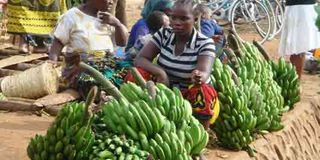How we can address agricultural price instability

What you need to know:
Archaeologist discoveries have shown that agriculture was developed during 10,000 BC when human started settlements and began farming.
Agriculture is among the economic activities that people do to earn income. Agriculture involves the cultivation of crops and animal keeping. Archaeologist discoveries have shown that agriculture was developed during 10,000 BC when human started settlements and began farming.
Statistical data indicates that agriculture accounted for 32 per cent of GDP in Africa in 2016. Agriculture in Africa offers a great potential for poverty reduction and job creation, especially in rural areas where it is the main economic activity.
Sixty-five per cent of the workforce in Africa is employed in agriculture. However, the sector suffers many problems, including diseases, price instability, poor seeds and sustained neglect, which has resulted in Africa becoming a great importer of agricultural products and food processing products from developed countries.
Sustainable agriculture
But many countries have undertaken efforts to promote sustainable agriculture to fight against hunger, poverty and increase the value of agricultural products to export processed output instead of raw material.
In Tanzania, the agricultural sector employs over 70 per cent of the population. The country has over 44 million hectares of arable, land but only 33 per cent of this amount is cultivated. Among the main crops cultivated are maize, millet, rice, wheat, cassava, potatoes and beans. So far Tanzania is the biggest producer and exporter of beans to ten countries, including Uganda, Rwanda, Malawi, South Africa, Zambia, Malawi, Democratic Republic of Congo, Burundi, Zimbabwe as well as India.
In addition, in 2014, 2015 and 2016 agriculture contributed to GDP growth by 28.8 per cent, 29 per cent and 29.1 per cent, respectively. Yet despite all these achievements, challenges remain that need to be addressed if farmers are to benefit to the maximum from agriculture.
Among the challenges is price volatility that has had a negative impact on farmers’ income. After a good harvest, prices tend to decline while during poor harvests price rise. The effect of unstable prices undermines the efforts to alleviate poverty, especially in rural areas where large populations are engaged in agriculture.
But this problem can be solved using financial mechanism called commodity futures contract. Future is the written agreement between two parties: buyer and seller, which specifies the terms of trade for future delivery. Using futures, seller and buyer will agree on product to exchange, price, quality, quantity and delivery at certain dates in the future. This is to say farmer sells his product today, for example during cultivation but delivers them in the future after harvest.
Mitigate risks
Commodity futures help to mitigate risks associated with price swings because they allow farmers to sell and buy futures and physical products at the same time. Losses or gains made on futures or on market prices tend to offset each other thus minimising the risk of price fluctuation
Advantage of using future contract is that it locks the price, hence ensure stable incomes to farmers in case of price downturn in the future. To hedge against price fluctuation, the idea of establishing futures contracts came up and that’s how futures exchange was evolved.
To understand how futures on agricultural output work consider these two scenarios. First scenario, during good harvest when supply is plentiful and farmer is concerned with the drop of price of rice, he may sell three months future contract to supplier; food processing company, at Sh90,000 per 100 kg bag, and say the current market price is Sh80,000 per a 100 kg bag.
After six months, the price of future falls to Sh85,000 and market price falls to Sh75,000 due to oversupply. The farmer can mitigate the risk simply by selling simultaneously two future contacts as well as buying rice; one to sell 100 kg of rice bag at Sh90,000 and another to purchase 100 kg rice bag at Sh85,000, and immediately sell at market price at Sh75,000 per bag.
The farmer makes a profit of Sh5,000 on the futures contracts and Sh75,000 selling at market price, totaling Sh80,000 net sales. The second scenario where there has been a bad harvest and demand is higher than supply and expectations are that in near future price will rise. Current market price for 100 kg rice bag is Sh100,000 and six months futures price is Sh110,000. After six months, market price rise to Sh120,000 and future price is Sh115,000. Therefore, the farmer loses Sh5,000 on futures but market price increase makes him gain Sh120,000, totaling Sh115,000 net sales. Price volatility makes big losers and winners, hence futures contract provides buffer against price swings and lock the income for farmers. If African countries can establish and use commodity futures exchange market, this will help to stabilise prices.
Jimmy Lishabi is an economist and financial analyst




